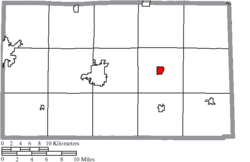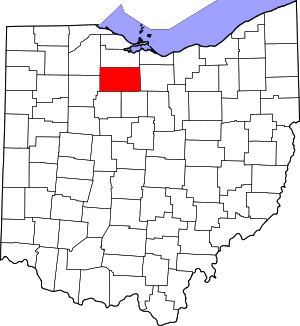Republic, Ohio
Republic is a village in Seneca County, Ohio, United States. The population was 549 at the 2010 census.
Republic, Ohio | |
|---|---|
 Aerial view of Republic | |
 Location of Republic, Ohio | |
 Location of Republic in Seneca County | |
| Coordinates: 41°7′18″N 83°1′3″W | |
| Country | United States |
| State | Ohio |
| County | Seneca |
| Government | |
| • Type | Village council |
| • Mayor | Jeff L. Larick |
| Area | |
| • Total | 0.86 sq mi (2.23 km2) |
| • Land | 0.86 sq mi (2.23 km2) |
| • Water | 0.00 sq mi (0.00 km2) |
| Elevation | 879 ft (268 m) |
| Population | |
| • Total | 549 |
| • Estimate (2019)[4] | 520 |
| • Density | 603.25/sq mi (232.85/km2) |
| Time zone | UTC-5 (Eastern (EST)) |
| • Summer (DST) | UTC-4 (EDT) |
| ZIP code | 44867 |
| Area code(s) | 419 |
| FIPS code | 39-66320[5] |
| GNIS feature ID | 1061596[2] |
History
In 1834, Sidney Smith hired R.M. Shoemaker of Cincinnati to survey a new town at the corners of sections 15, 16, 21, and 22 in Scipio Township. He called it "Republic," though it was known by many early settlers simply as "Scipio Center."[6]
With the arrival of a rail line from Sandusky in 1841, Republic became a popular trading center. Stores, warehouses, shops, and factories sprang up almost overnight. A second rail line was contemplated to run between Republic and Melmore in Eden Township.
When the old Seneca County courthouse at Tiffin burned on May 21, 1841, efforts were made to designate Republic as the county seat, but these were unsuccessful. Republic's fortunes began to decline when the new Cincinnati, Sandusky & Cleveland Railroad bypassed it to make a straight run to Tiffin.
The town was stimulated by the construction of the Baltimore and Ohio Railroad. The railroad passes via an arch bridge over what is now State Route 19e.
Republic's motto is "Small in Size, Big in Heart." Written by Seneca East student Michelle Wheatley, it was selected in a contest of popular submissions.
Geography
Republic is located at 41°7′18″N 83°1′3″W (41.121793, -83.017478).[7]
According to the United States Census Bureau, the village has a total area of 0.86 square miles (2.23 km2), all land.[8]
Demographics
| Historical population | |||
|---|---|---|---|
| Census | Pop. | %± | |
| 1850 | 917 | — | |
| 1860 | 636 | −30.6% | |
| 1870 | 481 | −24.4% | |
| 1880 | 715 | 48.6% | |
| 1890 | 584 | −18.3% | |
| 1900 | 656 | 12.3% | |
| 1910 | 475 | −27.6% | |
| 1920 | 393 | −17.3% | |
| 1930 | 512 | 30.3% | |
| 1940 | 546 | 6.6% | |
| 1950 | 615 | 12.6% | |
| 1960 | 729 | 18.5% | |
| 1970 | 705 | −3.3% | |
| 1980 | 656 | −7.0% | |
| 1990 | 611 | −6.9% | |
| 2000 | 614 | 0.5% | |
| 2010 | 549 | −10.6% | |
| Est. 2019 | 520 | [4] | −5.3% |
| U.S. Decennial Census[9] | |||
2010 census
As of the census[3] of 2010, there were 549 people, 220 households, and 151 families living in the village. The population density was 638.4 inhabitants per square mile (246.5/km2). There were 245 housing units at an average density of 284.9 per square mile (110.0/km2). The racial makeup of the village was 98.2% White, 0.4% African American, 0.5% Native American, 0.2% Asian, and 0.7% from two or more races. Hispanic or Latino of any race were 1.8% of the population.
There were 220 households, of which 35.9% had children under the age of 18 living with them, 47.7% were married couples living together, 14.1% had a female householder with no husband present, 6.8% had a male householder with no wife present, and 31.4% were non-families. 25.9% of all households were made up of individuals, and 13.1% had someone living alone who was 65 years of age or older. The average household size was 2.50 and the average family size was 2.93.
The median age in the village was 35.5 years. 25.9% of residents were under the age of 18; 7.4% were between the ages of 18 and 24; 29.1% were from 25 to 44; 26.2% were from 45 to 64; and 11.3% were 65 years of age or older. The gender makeup of the village was 50.1% male and 49.9% female.
2000 census
As of the census[5] of 2000, there were 614 people, 223 households, and 165 families living in the village. The population density was 711.4 people per square mile (275.7/km2). There were 237 housing units at an average density of 274.6 per square mile (106.4/km2). The racial makeup of the village was 99.67% White, 0.33% from other races. Hispanic or Latino of any race were 1.79% of the population.
There were 223 households, out of which 39.0% had children under the age of 18 living with them, 58.3% were married couples living together, 10.3% had a female householder with no husband present, and 26.0% were non-families. 22.9% of all households were made up of individuals, and 9.4% had someone living alone who was 65 years of age or older. The average household size was 2.72 and the average family size was 3.19.
In the village, the population was spread out, with 29.6% under the age of 18, 9.4% from 18 to 24, 28.7% from 25 to 44, 19.1% from 45 to 64, and 13.2% who were 65 years of age or older. The median age was 33 years. For every 100 females there were 101.3 males. For every 100 females age 18 and over, there were 99.1 males.
The median income for a household in the village was $37,813, and the median income for a family was $45,083. Males had a median income of $32,813 versus $20,956 for females. The per capita income for the village was $14,875. About 7.5% of families and 7.6% of the population were below the poverty line, including 6.9% of those under age 18 and 3.7% of those age 65 or over.
References
- "2019 U.S. Gazetteer Files". United States Census Bureau. Retrieved July 28, 2020.
- "US Board on Geographic Names". United States Geological Survey. 2007-10-25. Retrieved 2008-01-31.
- "U.S. Census website". United States Census Bureau. Retrieved 2013-01-06.
- "Population and Housing Unit Estimates". United States Census Bureau. May 24, 2020. Retrieved May 27, 2020.
- "U.S. Census website". United States Census Bureau. Retrieved 2008-01-31.
- Lang, William (1880). History of Seneca County, from the Close of the Revolutionary War to July, 1880. Transcript Printing Company. pp. 587.
- "US Gazetteer files: 2010, 2000, and 1990". United States Census Bureau. 2011-02-12. Retrieved 2011-04-23.
- "US Gazetteer files 2010". United States Census Bureau. Archived from the original on 2011-02-20. Retrieved 2013-01-06.
- "Census of Population and Housing". Census.gov. Retrieved June 4, 2015.
Further reading
- History of Seneca County, by W. Lang, Transcript Publishing Company, Springfield, Ohio, 1880. Pages 586-592.
